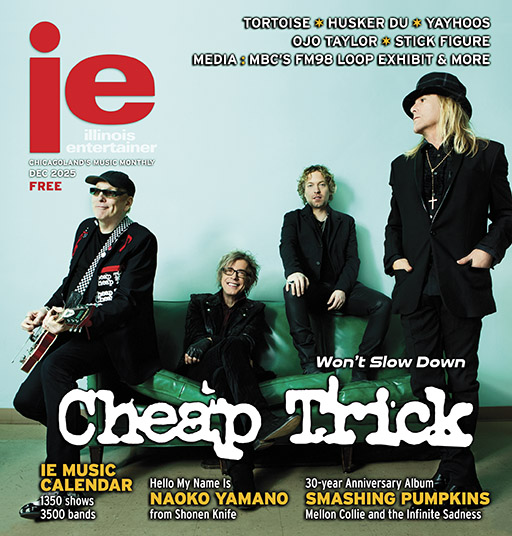Cover Story: Touch And Go 2
The only people Rusk and Pfahler knew here were the members of Big Black. Rusk had met frontman Steve Albini on the panel of the New Music Seminar in New York and, just as he had with MacKaye, hit it off, thus forging a dynamic partnership. Big Black played a pre-Graystone Detroit show Rusk was booking, “and stayed up all night barbecuing and talking about blowing stuff up, which we both loved to do. Friends ever since.”
When Touch And Go arrived in Chicago in late ’86, the Albini pipeline fed Rusk bands and suddenly a respectable roster turned into an impressive one with Big Black, Urge Overkill, Scratch Acid, Butthole Surfers, and Didjits. “Literally, it’s the connections between people that you know kind of thing,” Rusk says. “Like we moved here only knowing Big Black. Who did we start working with after we moved here? Urge Overkill, who were friends with Steve at the time. Then Big Black broke up and Scratch Acid broke up and what became of that? Steve’s next band, Rapeman, with David Sims from Scratch Acid. We were friends with Scratch Acid, and then David Yow ended up moving to Chicago just because Rey Washam and David Sims, his buddies from Scratch Acid, were now in Steve’s band and David . . . missed them? You’d have to ask him. But he moved up here and Rapeman broke up and The Jesus Lizard formed. There’s some sort of common thread going through all of that.”
Things being the way they are, however, Rusk and Pfahler, who had earlier married, split and Rusk assumed full control of the label, moving to a warehouse near Irving Park Road and Western Avenue in 1989. While his personal life had temporarily unraveled, Touch And Go surged. In 1990, he created a sister label, Quarterstick, to release music he didn’t feel fit into what he thought Touch And Go was doing. He also “computerized the company in a really serious sort of way that was overkill for who we were at that point in time.” But what it allowed him to do was create Touch And Go’s distribution arm. “Quite often [a] creative sort of personality type is inherently also not naturally good at the business side of things. I thought, ‘We’re really good with our vendors, we’re really good with distribution, we have a great distribution network, we’re great at getting paid,’ which was really difficult to do back then, ‘and we’ve systemized it all with this computer. We could help a lot of other labels with the part of the business that doesn’t come naturally to a lot of people. It would be good for them, and it would be good for us.’ So in 1990, we started doing manufacturing and distributing for some other labels.”
Touch And Go turned into an empire at a key time because before anyone would know it, “Smells Like Teen Spirit” was on the radio and the inmates of the indie rock asylum had crashed the gates. Major labels were looking to sign any band that could be the next Nirvana — mostly bands who sounded exactly like Nirvana — and gone were Urge Overkill, Butthole Surfers, and eventually The Jesus Lizard. Albini, who had been firing scathing letters attacking peoples’ credibility since the ’80s, was now at odds with some of his closest friends, even engaging Chicago Reader columnist Bill Wyman in a famous Liz Phair debate. Rusk was less vocal.
“[I was] probably more hurt than angry,” he admits, “but reasonably quickly just decided I wasn’t going to let my feelings get hurt too much by it. I could guilt them into not doing it — is that any good for anybody? I only want to work with people who understand what we do and think, ‘That’s the way I want to do it.’
“But it was also a time of immense growth for indie labels, because suddenly tons of mainstream people — who would never have thought for a second about listening to something other than what’s on major labels — had their attention drawn to the fact Nirvana had come from an underground label. There must be other interesting music on these smaller labels. So suddenly you were able to sell more records and it was exciting that bands that we loved we could get more attention for them.”
History bears him out. While you could argue every indie label had a stacked roster in the ’90s, Rusk had Arcwelder, Seam, Girls Against Boys, Don Caballero, reissued the whole of Big Black’s records, Slint, Brainiac, Polvo, and Shellac, while Quarterstick bore Henry Rollins, Pegboy, Therapy?, Mekons, June Of 44, Rachel’s, and Calexico. Everything was working.
“It was mainly record-to-record, handshake 50/50 deals — what we’ve done with everything our whole existence,” Rusk says, pointing out Touch And Go stuck with their original model even when tying bands down would have seemed prudent. “We were particularly vulnerable, I suppose, with the predatory tactics of the majors.”
But it wouldn’t be the majors tugging on the loose thread.
Category: Monthly











